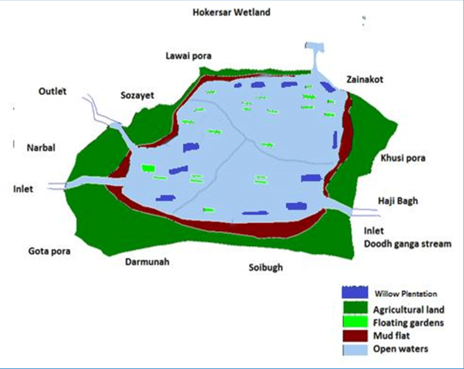ECOLOGY & ENVIRONMENT
HOKERSAR WETLAND
The Hokersar wetland in Kashmir Valley has faced water shortages from deficient rainfall, impacting migratory bird arrivals.
ABOUT

- Geography: Largest bird reserve in the Kashmir Valley and is situated in the Jhelum River basin.
- Hydrological Sources: The reserve is fed by the two perennial inlet streams; Doodhganaga from the east and Sukhnag Nallah from the west.
- Significance: It is a Ramsar site and also known as the “International Bird Airport” of Kashmir due to its role as a critical habitat for migratory birds.
- Fauna: It serves as a pathway to 68 waterfowl species such as Large Egret, Great Crested Grebe, Little Cormorant, Common Shelduck, Tufted Duck and endangered White-eyed Pochard, coming from Siberia, China, Central Asia, and Northern Europe.
- Fauna: It serves as a pathway to 68 waterfowl species such as Large Egret, Great Crested Grebe, Little Cormorant, Common Shelduck, Tufted Duck and endangered White-eyed Pochard, coming from Siberia, China, Central Asia, and Northern Europe.
- Flora: The wetland is the only site with the remaining reedbeds of Kashmir.
Aquatic Flora includes species like Typha, Phragmites, Eleocharis, Trapa, and Nymphoides, forming complexes from shallow to open water zones.
CONCERNS FOR THE WETLAND
- Deficient Rainfall: The primary concern leading to reduced water levels, impacting bird migration.
- Illegal Sand Mining: Disturbs the natural landscape and water flow.
- Encroachment: Human activities have encroached upon wetland areas, reducing its effective size.

-1721391937657.png)

